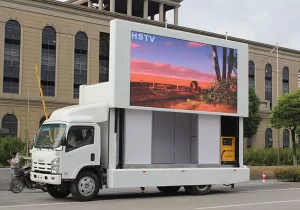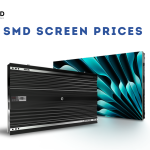SMD Screens in Automotive: Revolutionizing In-Car Displays
In today’s automotive landscape, technological advancements continue to redefine the driving experience, and one domain that stands out prominently is in-car displays. The emergence of Surface Mount Device (SMD) screens has revolutionized in-car displays, setting a new standard of excellence in terms of functionality, aesthetics, and user experience.
As digitalization takes center stage in the automotive industry, this article aims to explore the transformative impact of SMD screens on the driving environment. From enhanced clarity and interactivity to sleek designs and seamless integration, we delve into how these cutting-edge displays are reshaping the automotive industry and redefining the way drivers interact with their vehicles. Join us on this informative journey to understand how SMD screens have become an indispensable component in contemporary automotive innovation.
Table of Contents
- Advantages of SMD Screens in Automotive Displays
- Enhancing User Experience: Improved Clarity and Image Quality
- Increasing Safety and Functionality: Multifunctional features and Interactive Capabilities
- Key Considerations for Implementing SMD Screens in Automotive Displays
- Q&A
- Future Outlook

Advantages of SMD Screens in Automotive Displays
SMD screens (Surface Mount Device screens) have brought a revolutionary change to in-car displays in the automotive industry. These advanced screens offer a wide range of advantages over traditional displays, making them the preferred choice for modern automobiles.
One of the key is their superior image quality. With their high resolution and vibrant colors, these screens provide crystal clear visuals that enhance the overall driving experience. Whether it’s displaying navigation maps, vehicle information, or entertainment content, SMD screens ensure that every detail is presented with utmost clarity and precision.
Another notable advantage of SMD screens is their compact size and flexibility. These screens are designed to be highly space-efficient, enabling manufacturers to incorporate them seamlessly into the dashboard or other areas of the car’s interior. This not only enhances the aesthetics of the vehicle but also allows for greater design freedom. Additionally, SMD screens can be curved or molded to fit curved surfaces, providing endless possibilities for innovative and stylish display designs in modern cars.
In summary, SMD screens in automotive displays are revolutionizing the way we interact with in-car technology. The superior image quality, compact size, and flexibility of these screens make them an ideal choice for delivering immersive and visually appealing experiences to drivers and passengers alike. Whether it’s navigating unknown roads or simply enjoying entertainment on the go, SMD screens offer a cutting-edge solution that enhances the functionality and overall appeal of automotive displays.

Enhancing User Experience: Improved Clarity and Image Quality
In the ever-evolving world of automotive technology, SMD screens are taking center stage and revolutionizing in-car displays. These sleek, advanced screens offer a multitude of benefits that greatly enhance the user experience. One standout feature is the improved clarity and image quality, which creates a visually stunning and immersive environment for both drivers and passengers.
With SMD screens, gone are the days of pixelated or distorted images. The cutting-edge technology behind these displays ensures that every detail is crisp, clear, and true-to-life. Whether it’s navigating through a map, streaming a video, or adjusting vehicle settings, users can expect a visually pleasing experience like never before.
Furthermore, SMD screens provide exceptional color accuracy and vibrant imagery. The enhanced color saturation brings content to life, making it more engaging and captivating for those on the road. Whether watching a movie during a long journey or using the screen for work purposes, the vibrant display enhances productivity and enjoyment.
In addition to the impressive visual display, SMD screens also offer a wide viewing angle. This means that no matter where one is seated in the vehicle, they can still enjoy optimal visual quality without any loss of detail. This is particularly important for large families or groups traveling together, as everyone can have a perfect view from their seat.
The benefits of SMD screens extend beyond just visual quality. These displays are designed to be energy efficient, reducing the strain on the vehicle’s battery while providing outstanding performance. Additionally, SMD screens are often equipped with touch functionality, allowing for intuitive and seamless interaction with the display. Whether it’s a pinch-to-zoom gesture or a swipe to change screens, the user experience is made even more convenient and user-friendly.
In summary, SMD screens are changing the game when it comes to in-car displays. The improved clarity and image quality they offer create an immersive environment that enhances the user experience. With vibrant colors, exceptional detail, and a wide viewing angle, these displays provide a visually stunning experience for everyone in the vehicle. The combination of energy efficiency and touch functionality further adds to the convenience and usability of SMD screens. As automotive technology continues to advance, it’s clear that SMD screens are leading the way in revolutionizing in-car displays.

Increasing Safety and Functionality: Multifunctional features and Interactive Capabilities
In today’s digital age, the automotive industry is continuously pushing the boundaries of innovation. One revolutionary advancement that is transforming in-car displays is the use of Surface Mounted Device (SMD) screens. These state-of-the-art screens are enhancing the safety and functionality of vehicles by incorporating multifunctional features and interactive capabilities.
SMD screens offer a versatile and dynamic experience for drivers and passengers alike. With their high-resolution displays and vibrant colors, SMD screens provide excellent visibility, ensuring that important information such as navigation directions, vehicle speed, and fuel consumption are easily accessible at a glance. Additionally, these screens can be customized to fit the unique needs and preferences of drivers, allowing for personalized user experiences.
Moreover, SMD screens are equipped with interactive capabilities that significantly improve driver engagement and safety. By incorporating touch-sensitive technology, users can effortlessly control various car functions, such as adjusting the temperature, selecting entertainment options, or answering phone calls, all without taking their eyes off the road. This hands-on approach enhances driver focus and minimizes distractions, ultimately contributing to a safer driving experience.
Furthermore, the multifunctional features of SMD screens ensure a seamless integration of essential functions, avoiding cluttered controls and excessive buttons. For instance, these screens can display real-time weather updates, traffic information, and even provide recommendations for nearby gas stations or restaurants. The intuitive nature of SMD screens streamlines the user interface, making it easier and more efficient for drivers to interact with their vehicles.
In conclusion, the introduction of SMD screens in automotive displays is truly revolutionizing the way we experience our cars. With their multifunctional features and interactive capabilities, these cutting-edge screens are enhancing safety, functionality, and overall user experience. As technology continues to advance, we can expect even more innovative developments in the field of in-car displays, ensuring that future vehicles provide a seamless and intuitive digital companion for drivers.

Key Considerations for Implementing SMD Screens in Automotive Displays
With the increasing demand for advanced technology in automobiles, the implementation of Surface Mounted Device (SMD) screens has revolutionized in-car displays. These screens offer high-resolution visuals and vibrant colors, enhancing the overall driving experience. However, before integrating SMD screens into automotive displays, there are several key considerations to keep in mind.
- Durability: Automotive displays are subject to various environmental factors such as heat, cold, humidity, and vibrations. It is crucial to ensure that SMD screens can withstand these conditions without compromising performance or longevity. Manufacturers should select screens with robust build quality and incorporate protective measures such as tempered glass or coatings to resist scratches and impacts.
- Optimal Viewing Angles: In-car displays need to be easily visible to both the driver and passengers. SMD screens should offer wide viewing angles, minimizing color distortion and ensuring clear visuals from different seating positions. Evaluating the screen’s viewing angle specifications can help determine its suitability for automotive applications. Additionally, screens with anti-glare and anti-reflective coatings can significantly enhance visibility, particularly under direct sunlight.
To make informed decisions when implementing SMD screens, manufacturers and designers in the automotive industry should carefully evaluate these key considerations. By selecting durable screens with optimal viewing angles, automotive displays can provide a seamless and visually captivating experience for drivers and passengers alike.
Q&A
Q: What are SMD screens in automotive, and how are they revolutionizing in-car displays?
A: SMD screens refer to Surface-Mount Device screens that are used in automotive applications. These screens are revolutionizing in-car displays by offering several key benefits, including improved visibility, enhanced design flexibility, higher resolution, and increased durability.
Q: How do SMD screens improve visibility in automotive displays?
A: SMD screens use advanced technologies such as high brightness LEDs and optical bonding to improve visibility in various lighting conditions. This allows drivers and passengers to easily read the information displayed on the screen, even in bright sunlight or low-light environments.
Q: What design flexibility do SMD screens offer in automotive displays?
A: SMD screens can be customized to fit different shapes, sizes, and styles, offering automakers greater design flexibility. These screens can be seamlessly integrated into the overall aesthetics of the vehicle’s interior, allowing for a visually pleasing and cohesive design.
Q: How does the higher resolution of SMD screens impact in-car displays?
A: SMD screens provide higher resolution, resulting in sharper and more detailed visuals. This enables automakers to display intricate graphics, realistic icons, and crisp text, enhancing the overall user experience and making the information displayed on the screen more legible and engaging.
Q: What makes SMD screens more durable than conventional displays?
A: SMD screens utilize robust materials and are designed to withstand harsh environmental conditions typically encountered in automotive environments, such as extreme temperatures, shock, vibration, and exposure to dust and moisture. Their durability ensures longevity and reliability, reducing the need for frequent repairs or replacements.
Q: Can SMD screens be integrated with other automotive systems?
A: Yes, SMD screens can be seamlessly integrated with other automotive systems, such as infotainment, navigation, HVAC controls, and driver assistance features. This integration allows for a unified user interface and simplifies the operation of various functions, enhancing the overall user experience in the vehicle.
Q: Are there any potential challenges or drawbacks associated with SMD screens in automotive?
A: Although SMD screens bring numerous advantages to automotive displays, there are a few potential challenges to consider. Firstly, the cost of implementing SMD screens may be higher compared to conventional displays. Additionally, the complexity of the technology might require skilled technicians for installation or maintenance.
Q: How do SMD screens contribute to the future of automotive displays?
A: SMD screens are paving the way for more advanced and innovative automotive display solutions. As technologies continue to improve, we can expect SMD screens to offer even higher resolutions, increased flexibility, and new features like curved or flexible form factors, further enhancing the in-car user experience and safety.
Future Outlook
In conclusion, it is evident that the incorporation of SMD screens in the automotive industry has brought about a revolutionary transformation in in-car displays. These advanced screens, with their superior image quality, enhanced durability, and versatility, have become an integral part of modern vehicles, offering a seamless and intuitive user experience.
Gone are the days of traditional bulky displays that hindered design flexibility and compromised on visual clarity. The implementation of SMD screens has allowed automakers to revolutionize the interior cabin, providing drivers and passengers with a futuristic and sophisticated environment.
Moreover, the integration of SMD screens has not only enhanced the aesthetic appeal of in-car displays but also improved safety and functionality. With their ability to relay vital information such as speed, navigation, and vehicle diagnostics in real-time, these screens have become indispensable tools for drivers, ensuring a safer and more convenient driving experience.
Additionally, the advanced technology embedded within SMD screens opens up new opportunities for customization and personalization. With the ability to adapt to changing lighting conditions, adjust contrast levels, and display vivid colors, these screens offer endless possibilities for tailoring the in-car experience to suit individual preferences.
Furthermore, with the rise of electric and autonomous vehicles, SMD screens are poised to play an even more significant role in the future. As these vehicles become an integral part of our daily lives, SMD screens will continue to evolve, offering seamless integration with smart connectivity features and advanced driver assistance systems.
While SMD screens have undoubtedly revolutionized in-car displays, it is crucial for automakers to ensure their reliability, durability, and longevity. Striking a delicate balance between innovation and practicality will be key in meeting the evolving demands of the automotive industry and providing consumers with a truly transformative driving experience.
In summary, the advent of SMD screens in the automotive industry has ushered in a new era of in-car displays. These screens have revolutionized the way drivers and passengers interact with their vehicles, offering unparalleled image quality, safety, customization, and functionality. As the automotive industry continues to evolve, we can look forward to further advancements in SMD screen technology, opening up a world of possibilities for the future of in-car experiences.
SMD Screens in Automotive: Revolutionizing In-Car Displays
Contact Us For Free Consultation at 0306-1333384
Powered By BIACommunication






